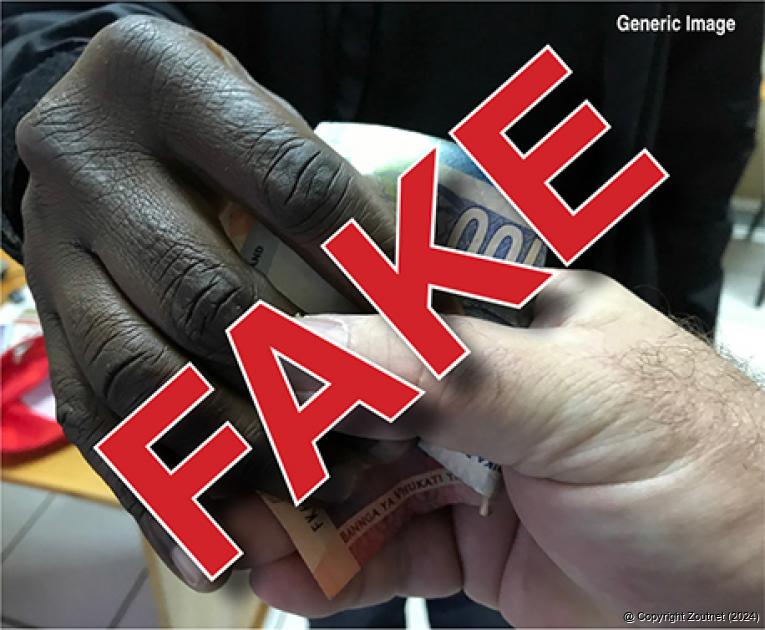

ADVERTISEMENT:

On closer inspection the R100 banknote was found to be fake. The colour basically matched that of a real R100 note, but the “feel and texture” of the paper were off. Viewed under an ultraviolet light, none of the parts that are supposed to light up did so.
Beware of counterfeit money doing the rounds
Residents are warned that counterfeit money is once again being circulated by unscrupulous criminals offering it as payment for products and services. This warning comes from a Louis Trichardt resident who received fake R100 notes as payment on two different occasions.
The resident (who preferred to remain anonymous) sells tomatoes wholesale to the public from their farm. Some of the bigger transactions can run into thousands of rands. “On Sunday, 28 February, a customer came and paid for the tomatoes in cash. When I went to deposit the cash at an outside bank ATM, the machine, however, rejected one R100 note,” said the resident.
On closer inspection the R100 banknote was found to be fake. The colour basically matched that of a real R100 note, but the “feel and texture” of the paper were off. Viewed under an ultraviolet light, none of the parts that are supposed to light up did so.
The dead giveaway was, however, the serial number on the note – TK8415994D - a number that the resident had seen before because the same number had appeared on another fake R100 note used to pay for tomatoes at their farm a couple of weeks before. This note was also rejected by the bank.
The resident warned local businesses and farmers to be vigilant. “It both cases, the transaction was concluded on a Sunday and in both cases the fake notes were slipped in between real notes. It might seem that one fake R100 is not that much. But over a long period, it is a lot of money lost if you start adding up all the fake notes,” said the resident.
As forgers are becoming more “skilful” in their forgeries, the public find spotting the difference between real and fake bank notes increasingly difficult. When inspecting banknotes, an approach of Look, Feel, and Tilt should be adopted.
One of the features to look at is the security thread that appears as a shiny stripe on the front of a bank note. This stripe becomes a continuous solid line when the note is held up to the light. The words “SARB”, “Rand”, the denomination and the South African coat of arms should be visible. Also look for the watermark embedded into the banknote’s paper, which becomes visible when the note is held up to the light.
By lightly running your fingertips over the banknote, you can also feel the difference between real and fake banknotes. On the front of the banknote, the portrait of Nelson Mandela and the words SOUTH AFRICAN RESERVE BANK (SARB) will feel slightly raised or rough.
As for tilting the note, the metallic security thread will reflect light and exhibit a slight colour shift. The numerals on the bottom right of the banknote are also printed with a colour-changing ink. The R10 and R20 banknotes exhibit a slight colour shift, whereas the R50, R100 and R200 banknotes appear to have a moving line.
The newspaper would have loved to show our readers the safety features to look out for, but according to Section 14 of the SARB Act, only the SARB has the right to issue banknotes and coins in South Africa. “Any reproduction of banknote images – even for artistic or advertising uses – is strictly forbidden,” warns the SARB on its website. It has also urged members of the public who come into possession of counterfeit banknotes or coins to report this to their nearest police station.
To find out more on how to spot the difference between real and counterfeit banknotes, visit https://www.resbank.co.za/en/home/what-we-do/banknotes-and-coin#banknotes-item-d416b781ca. Scroll down to the “Check your banknotes” button.
News - Date: 11 March 2021

Recent Articles
-

Bekende akademikus verloor stryd teen kanker
26 April 2024 By Andries van Zyl -

Former mayor of Tshwane, Dr Murunwa Makwarela, passes away
26 April 2024 By Victor Mukwevho -

Community relieved after suspect gets caught
26 April 2024 By Elmon Tshikhudo -

Ystervrou van die Bosveld oorlede
26 April 2024 By Pétria de Vaal
Search for a story:

ADVERTISEMENT


Andries van Zyl
Andries joined the Zoutpansberger and Limpopo Mirror in April 1993 as a darkroom assistant. Within a couple of months he moved over to the production side of the newspaper and eventually doubled as a reporter. In 1995 he left the newspaper group and travelled overseas for a couple of months. In 1996, Andries rejoined the Zoutpansberger as a reporter. In August 2002, he was appointed as News Editor of the Zoutpansberger, a position he holds until today.
Email: [email protected]

ADVERTISEMENT:

